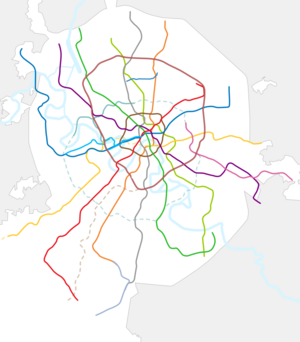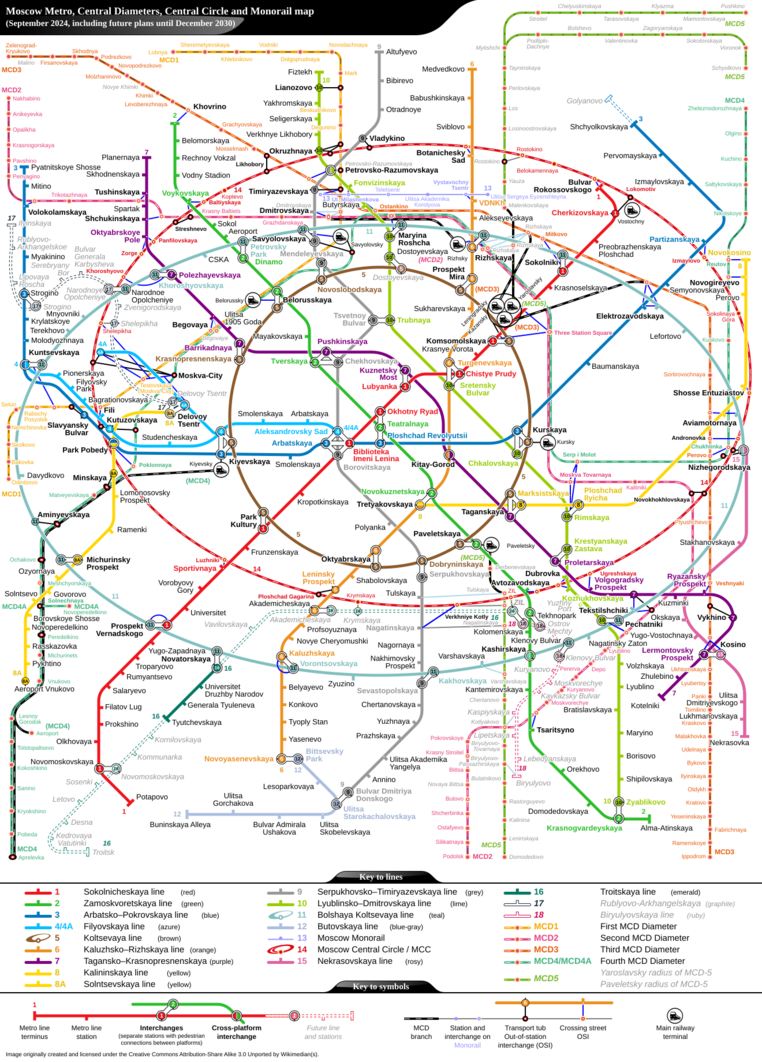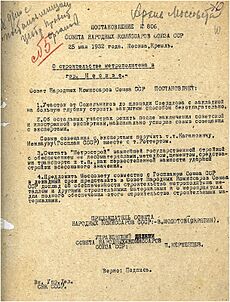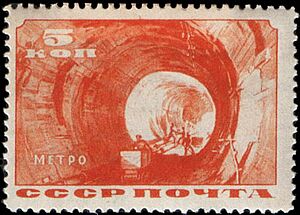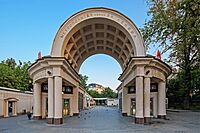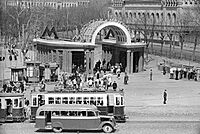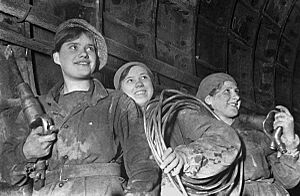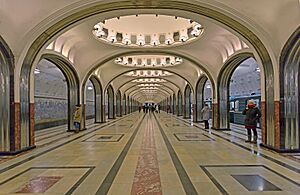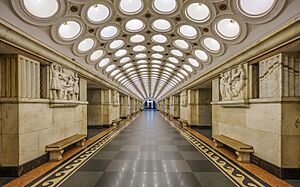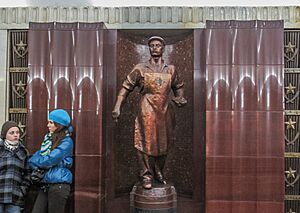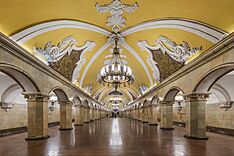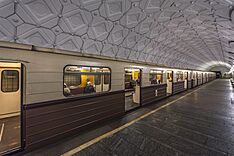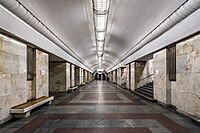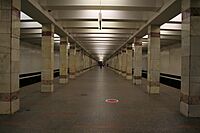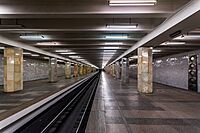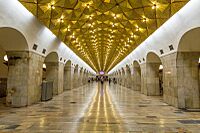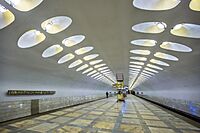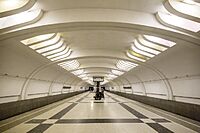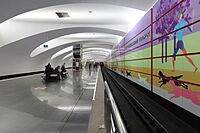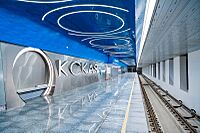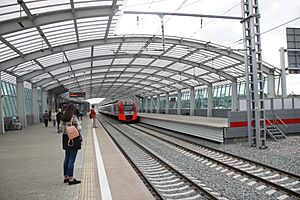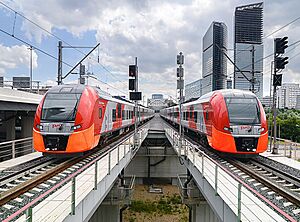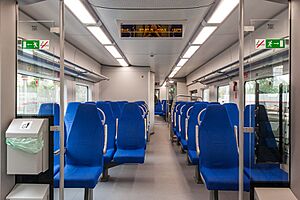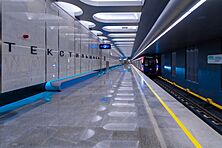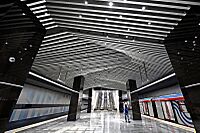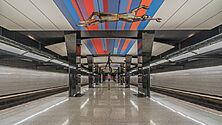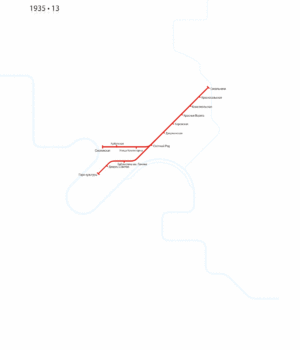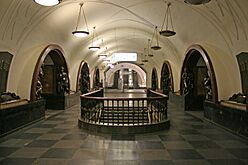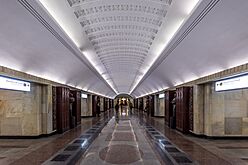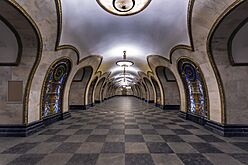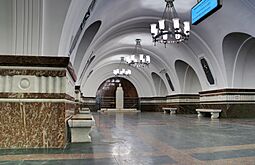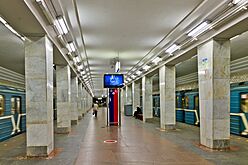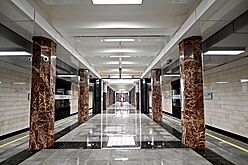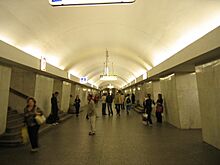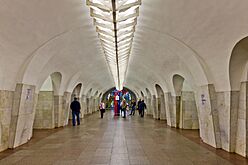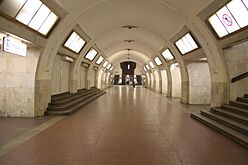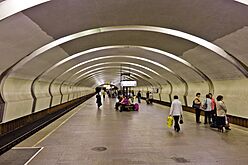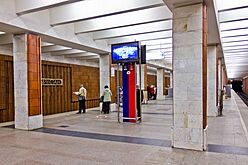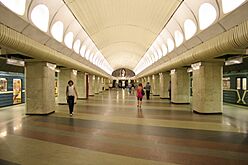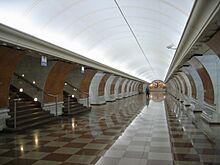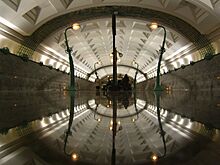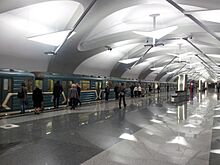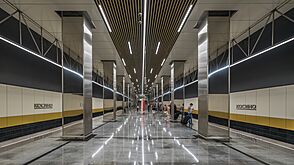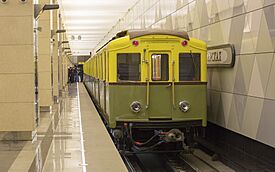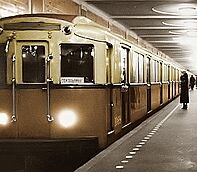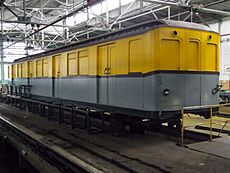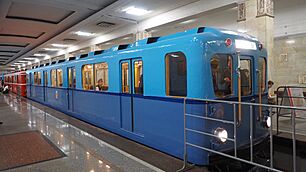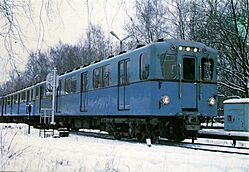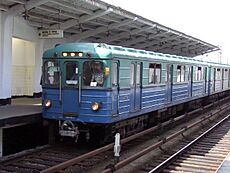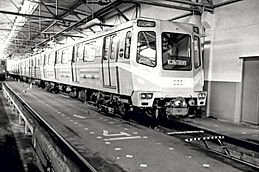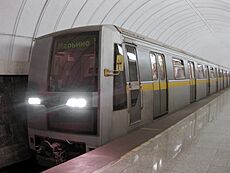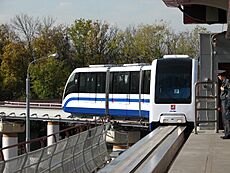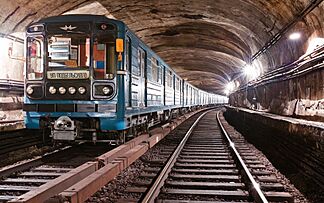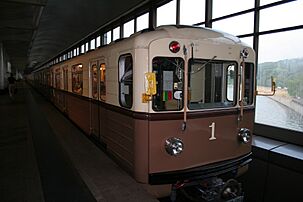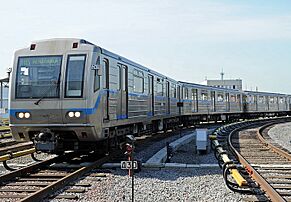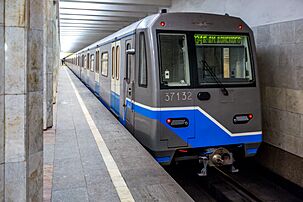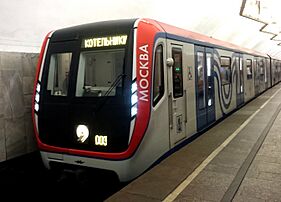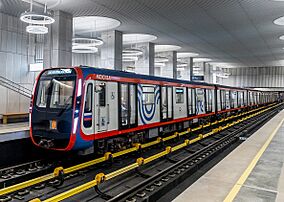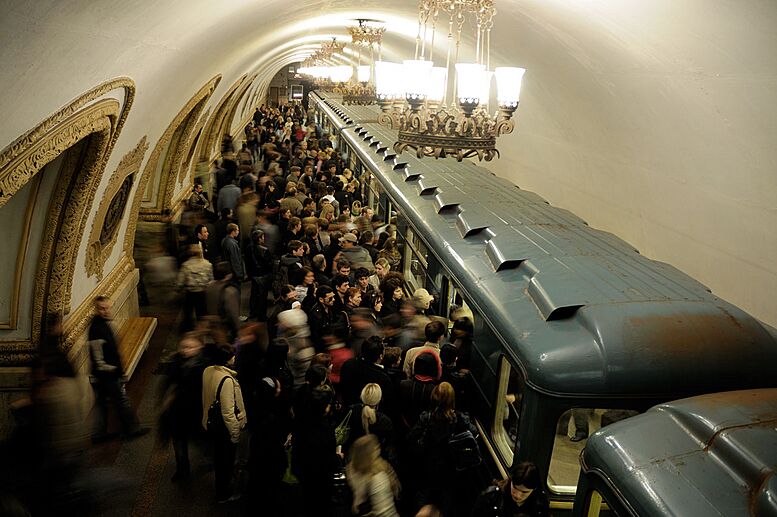Moscow Metro facts for kids
Quick facts for kids Moscow Metro |
|||
|---|---|---|---|
 |
|||
| Info | |||
| Owner | Government of Moscow | ||
| Locale | Federal city of Moscow and cities of Kotelniki, Krasnogorsk, Lyubertsy, Reutov in Moscow Oblast, Russia |
||
| Transit type | Rapid transit | ||
| Number of lines | 16 | ||
| Number of stations | 271 | ||
| Daily ridership | (average) 7.5 million (highest, 26 December 2014) 9.715 million |
||
| Chief executive | Viktor Kozlovsky | ||
| Operation | |||
| Began operation | 15 May 1935 | ||
| Operator(s) | Moskovsky Metropoliten | ||
| Headway | Peak hours: 1.5 - 1.7 mins Off-peak: 2.5 - 10 minutes |
||
| Technical | |||
| System length | 525.8 km (326.7 mi) | ||
| Track gauge | 1,520 mm (4 ft 11 27⁄32 in) | ||
| Electrification | 825 Volt DC third rail, | ||
| Average speed | 39.54 km/h (24.57 mph) | ||
| Top speed | 100 km/h (62 mph) | ||
|
|||
The Moscow Metro is a huge underground train system in the Moscow metropolitan area of Russia. It serves the capital city of Moscow and nearby towns. It opened in 1935 with just one line and 13 stations. It was the first underground railway system in the Soviet Union.
As of December 2024, the Moscow Metro has 271 stations and over 466 kilometers of tracks. This makes it the 8th longest metro system in the world. It is the longest in Europe and the longest outside China. Most of the system is underground. The deepest part is 73 meters deep at Park Pobedy station. This is one of the world's deepest underground stations.
The Moscow Metro is the busiest metro system in Europe. It is also the busiest in the world outside Asia. Many people see it as a tourist attraction because of its beautiful station designs. Trains run very often, especially during busy times. In February 2023, Moscow became the first city to have metro trains arrive every 80 seconds.
Contents
- The Metro's Name
- The Metro Logo
- How the Metro Works
- The Metro Network
- History of the Moscow Metro
- Metro Expansions
- Metro Stations
- Metro Trains
- Tickets and Fares
- Passenger Services
- Digital Services
- Statistics
- Notable Incidents
- Metro-2
- Cool Facts About the Metro
- See also
The Metro's Name
The full official name of the metro has been Moscow Order of Lenin and Order of the Red Banner of Labor V. I. Lenin Metro since 1955. This is usually shortened to V. I. Lenin Metro. You can see this shorter name on many stations. Even though there were ideas to remove Lenin's name, it is still part of the official name.
The metro's first official name was L. M. Kaganovich Metro. This was after Lazar Kaganovich, who helped build the early lines. When the Metro won an award called the Order of Lenin, its name changed to include that too. Later, in 1955, the name was changed to honor V.I. Lenin.
The Metro Logo
The first Moscow Metro line opened in 1935. It had a simple logo: a big letter M with the word "МЕТРО" (METRO). No one is completely sure who designed this first logo. People often think it was the architects of the first stations.
In 2014, the Moscow Metro started using a new, standard logo. This was part of a bigger plan to update all of Moscow's public transport.
How the Metro Works
The Moscow Metro is owned by the government. It is 449 kilometers long and has 15 lines and 263 stations. Most lines start in the center of Moscow and spread out like spokes on a wheel.
The Koltsevaya Line (Line 5) is a 20-kilometer circle line. It helps passengers travel between the different lines without going through the city center. The newer Moscow Central Circle (Line 14) and Bolshaya Koltsevaya line (Line 11) are even bigger circles. They are 54 km and 57 km long, serving areas further from the center.
Most stations and lines are underground. However, some parts are above ground. The Filyovskaya Line, Butovskaya Line, and the Central Circle Line are mostly above ground.
The Moscow Metro uses a special track width, like other Russian railways. Trains get their power from a "third rail" that carries 825 Volts of electricity. The average distance between stations is 1.7 kilometers. The shortest section is 502 meters long, and the longest is 6.62 kilometers. Because of the long distances between some stations, trains can travel at a good speed of 41.7 kilometers per hour.
The Moscow Metro opens at 5:25 AM and closes at 1:00 AM. All stations close at 1:00 AM for cleaning and repairs. During busy times in the morning and evening, trains arrive every 90 seconds or even faster.
In 2017, about 6.99 million passengers rode the metro every day. On December 26, 2014, a record 9.71 million people used the metro.
Since December 2, 2014, you can use free Wi-Fi on all Moscow Metro lines.
The Metro Network
Metro Lines
Each metro line has a name, a number, and a color. The color is often how people identify the line. For example, the red line is Line 1. When you are on a train going towards the city center (or clockwise on the Circle line), a male voice announces the next station. When you are going away from the city center (or anti-clockwise on the Circle line), a female voice announces it.
The Moscow Monorail used to be connected to the metro. It was a 4.7-kilometer line with six stations. It opened in 2008 and closed on June 27, 2025.
Note: Line 13 was the Moscow Monorail. The lines are still numbered as if it were there.
The Kakhovskaya line was a 3.3 km line with 3 stations. It closed for a long time for rebuilding. On December 7, 2021, Kakhovskaya station reopened as part of the Bolshaya Koltsevaya line. The renewed Varshavskaya and Kashirskaya stations also reopened as part of the Bolshaya Koltsevaya line, which was fully open by March 1, 2023.
Lines That Changed Names
- Sokolnicheskaya line was once called Kirovsko-Fruzenskaya.
- Zamoskvoretskaya line was once called Gorkovsko-Zamoskvoretskaya.
- Filyovskaya line was once called Arbatsko-Filyovskaya.
- Tagansko-Krasnopresnenskaya line was once called Zhdanovsko-Krasnopresnenskaya.
History of the Moscow Metro
Plans for a metro in Moscow started a long time ago, even before World War I. But these plans were put on hold because of wars and revolutions. In 1923, Moscow City Council created an office to design an underground railway. By 1928, they had a plan for the first route. In June 1931, the decision was made to start building the Moscow Metro.
The first lines were built following a plan by Lazar Kaganovich. The Metro was even named after him until 1955. Moscow Metro engineers also got advice from the London Underground, which is the world's oldest metro system. British experts helped with designs and construction plans.
However, during this time, some British engineers were arrested. This happened because the secret police were very suspicious. This event ended the involvement of British businesses in the USSR.
Early Construction Stages
The first line opened on May 15, 1935, at 7:00 AM. It was 11 kilometers long and had 13 stations. This day was celebrated as a big success for the country. About 285,000 people rode the Metro on its first day. People were very proud of its design. The Moscow Metro trains were quite fast for their time.
The first line connected Sokolniki to Okhotny Ryad. It then branched off to Park Kultury and Smolenskaya. This branch was later extended in 1937. It was the first Metro line to cross the Moskva River.
The second stage of construction was finished before World War II. In March 1938, the Arbatskaya branch was extended. In September 1938, the Gorkovskaya Line opened. The stations built during this time had beautiful designs, mixing art-deco style with Soviet themes. The Mayakovskaya station, which is very deep, was built then.
Building continued during World War II, even though it was slower. Two new sections of the Metro opened in 1943 and 1944. During the Battle of Moscow, metro stations were used as air-raid shelters. Important government meetings even took place on the platforms of Mayakovskaya station.
After the war, construction began on the fourth stage. This included the Koltsevaya Line (Circle Line). The stations built during this time are considered the most beautiful. The Circle Line was completed in 1954.
Metro as a Symbol of a "Bright Future"
When the Metro opened, it quickly became the most important part of Moscow's transport system. The art in the first 13 stations became famous. For example, the Sverdlov Square station showed scenes of daily life in the Soviet Union. The Metro was seen as a symbol of a new, modern society.
The Metro also showed off a style of art called Socialist Realism. This art style aimed to show how great the socialist society was. Every part of the Metro's design, from its beauty to its technology, was meant to inspire people.
The Moscow Metro was one of the most ambitious building projects in the USSR. Artists and architects wanted to create a place that felt bright and hopeful. They wanted it to represent a "bright future." With their shiny marble walls, high ceilings, and grand chandeliers, many stations look like "underground suns."
This grand design also showed how strong the underground structures were. This was important because the Metro could also be used as a bunker or bomb shelter.
Building the Metro: Industrialization and Mobilization
The building of the Moscow Metro was a huge project. It needed a lot of materials like steel. The country had to quickly develop its industries to produce these materials. This rapid growth of industry was called "industrialization."
The Metro also helped Moscow deal with its growing population. Many people moved to the city in the 1930s. The Metro helped improve the city's transport system.
The Communist Party had the power to bring together many people and resources for the project. This was called "mobilization." One main reason for this was to show the world that a socialist metro could be better than capitalist designs.
Lazar Kaganovich was in charge of this huge project. He was known for his strong leadership and for pushing workers to build quickly. The project brought in workers and materials from all over the Soviet Union. Miners, construction workers, and materials like iron, timber, and marble came from different regions.
Many unskilled workers were needed. The organization building the Metro, called Metrostroi, launched big campaigns to recruit them. They even printed newspapers and newsletters in different languages to attract workers.
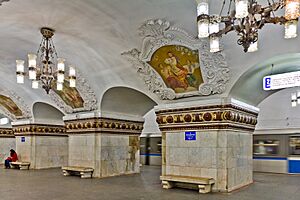
Later Soviet Stations
Stations from the Cold War Era
The start of the Cold War led to building very deep sections of the Arbatsko-Pokrovskaya Line. These stations were designed to be shelters in case of a nuclear war. They had strong gates and systems to keep people alive inside.
Changes in Design: Khrushchev's Era
In the late 1950s and 1960s, the fancy designs of new Metro stations were stopped. This was ordered by Nikita Khrushchev, who preferred simpler, more practical designs. The idea was to build stations cheaply and quickly.
Stations from this time were simple, often with walls covered in plain square ceramic tiles. Many stations looked very similar, only differing in the colors of their marble or tiles. This simpler building method sometimes caused problems. For example, tiles could fall off due to train vibrations.
Metro Stations in the Late USSR
By the mid-1970s, some of the grand architectural style returned. However, the newer, simpler station designs still continued. For example, Kaluzhskaya station from 1974 used tiles with a 3D effect. Medvedkovo from 1978 had complex decorations.
Some stations, like Kitay-Gorod (1971), were built for easy transfers between lines. They had a very simple color scheme. Other stations, like Babushkinskaya (1978), had no columns. Some deep stations, like Shabolovskaya (1980), had metal sheets on their walls instead of tiles.
In the city center, stations like Borovitskaya (1986) used red bricks and gray colors. The Tretyakovskaya station has two very different halls: one from 1971 and a newer one from 1986, which looks like the nearby Tretyakov Gallery museum.
Modern Stations in Russia
Modern stations built after the Soviet Union often have a more international and neutral style. They also have better technical quality.
- Ulitsa Akademika Yangelya station used to have bright orange lights.
- Park Pobedy, the deepest station, opened in 2003. It uses a lot of dark orange polished granite.
- Slavyansky Bulvar station has a plant-inspired design.
- Sretensky Bulvar station is decorated with paintings of nearby landmarks.
- Troparyovo (2014) has trees made of polished metal that hold diamond-shaped lights.
- Lomonosovsky Prospekt (Line 8A) is decorated with math equations.
- Olkhovaya (2019) uses plant themes with autumn colors.
- Kosino (2019) has a modern, high-tech style with thin LED lights.
Some older, plainer stations have been updated. For example, Akademicheskaya now has blue-striped white walls.
Moscow Central Circle (Line 14)
A new circle metro line, the Moscow Central Circle (Line 14), opened in September 2016. It was created by upgrading an old freight railway line. This old railway had been around for decades but was not electrified. New tracks and stations were built between 2014 and 2016. MCC stations have modern features like vending machines and free restrooms.
Line 14 uses full-sized trains called "Lastochka" (Swallow). This line connects northern residential areas to western and southern downtown areas. It has helped reduce crowding on the older Koltsevaya line. The trains on Line 14 have small folding tables and seats that face one direction, like on planes.
You can use the same "Troika" cards for the MCC as for the Moscow Metro and buses. You can transfer for free between the MCC and the Moscow Metro if your trip is less than 90 minutes.
Moscow Central Diameters (D Lines)
In 2019, new railway lines were added to the metro map as "line D1" and "line D2". These lines are like city trains that go through the city center. Line D3 opened in August 2023, and D4 opened in September 2023.
You can use Moscow's "Troika" cards on the MCD lines. You need to keep your ticket until you exit your destination station.
Big Circle Line (Line 11)
After the success of the Moscow Central Circle, another large circle line was developed. This is the Bolshaya Koltsevaya line (Line 11), or Big Circle Line.
Throughout the late 2010s, Line 11 was extended. In early 2023, the full circle was completed. Stations like Shelepikha, Khoroshovskaya, CSKA, and Petrovsky Park have shiny surfaces and polished granite.
As of spring 2023, the entire Big Circle Line is open. It stretches to the southern parts of the city. At 57.5 kilometers long, it is the longest subway line in the world.
Metro Expansions
Since the year 2000, many new metro projects have been finished. For example, the Serpukhovsko-Timiryazevskaya Line was extended. The Butovskaya Line, which is mostly elevated, opened in 2003. Vorobyovy Gory station, which had closed for repairs, reopened in 2002.
Another project was adding a branch off the Filyovskaya Line to the Moscow International Business Center. This included Vystavochnaya (2005) and Mezhdunarodnaya (2006) stations.
The Strogino–Mitino extension started with Park Pobedy in 2003. New stations like Kuntsevskaya and Strogino opened in 2008. Myakinino station was special because it was built with money from both the government and private companies.
The Lyublinskaya Line was extended in 2007 and 2010. In 2011, work began on the Third Interchange Contour, which is now the Big Circle Line. This new line helps reduce crowding on the older Circle Line.
In 2013, the Tagansko-Krasnopresnenskaya Line was extended. Spartak station, which had been unfinished for forty years, finally opened in 2014. The Sokolnicheskaya Line was also extended in 2014.
Future Plans
The Moscow Government and Russian Railways plan to upgrade more commuter railways to be like metro lines. New tracks and stations are being built for this.
Metro Stations
Of the metro's 250 stations, many are deep underground, some are shallow, and a few are at ground level or elevated.
The deep stations often have three vaults and columns or pylons. Shallow stations often have columns. There are also ground-level and elevated stations. One station, Vorobyovy Gory, is on a bridge.
Stations built during the time of Stalin were designed to be like "underground palaces." Stations like Komsomolskaya, Kiyevskaya, and Mayakovskaya are famous for their beautiful architecture, large chandeliers, and detailed decorations. They are like works of art.
Stations opened in the 21st century have a more modern and simple style.
Metro Trains
Metro platforms are usually at least 155 meters long. This allows for trains with eight cars. The only exceptions are some stations on the Filyovskaya Line, which can only fit six-car trains.
Most lines use eight-car trains. The Sokolnicheskaya line uses seven or eight cars. The original Koltsevaya line uses seven cars, and the Filyovskaya line uses six cars. The Butovskaya line uses shorter, three-car trains.
Trains No Longer Used
The V-type trains were originally from the Berlin U-Bahn. They were brought to Moscow after 1945 and used until 1968. A-type and B-type trains were specially made when the metro first opened.
The Moscow Monorail used special Intamin P30 trains, which had six short cars.
Trains Currently in Use
Today, the Metro mainly uses 81-style trains.
Some lines have newer, articulated 81-740/741 Rusich trains. The Butovskaya Line uses these trains because its platforms are shorter.
On the Moscow Central Circle, which is a regular railway line, ES2G Lastochka trains are used. These trains have five cars.
Tickets and Fares
The Moscow Metro usually charges one price for a single trip, no matter how far you go. However, the Moscow Central Diameters (MCD) lines use a system where the price depends on the zone you travel through.
The Moscow Metro ticket system lets you transfer for free between different types of transport within 90 minutes. This includes the MCC, MCD, trams, and buses.
Modern metro gates accept many ways to pay. You can use plastic cards like the Troika card, bank cards, or special souvenir tickets. You can even use biometric payments, which means your face or fingerprint can pay for your ride. Some cards have a short waiting time between uses.
History of Tickets
In the past, during the Soviet era, you just used coins to pay.
Later, plastic tokens were used. Then, magnetic stripe cards were introduced in the 1990s. By 1999, tokens were no longer accepted.
In 1998, the Moscow Metro was the first metro system in Europe to fully use "contactless" smart cards, called Transport Cards. These cards allowed unlimited trips for a certain number of days.
In 2004, the city started the Moscow Resident Social Card program. These free smart cards are for older people and other groups. They offer discounts and free travel on public transport.
Since 2006, some banks have offered credit cards that also work as metro tickets.
In 2007, the metro started using contactless disposable tickets. By 2008, Moscow Metro was one of the first major public transport systems to use only contactless tickets.
Modern Ticket System
On April 2, 2013, the Troika smartcard was introduced. This card is now the main way to pay for travel in Moscow. You can use one Troika card for the metro, MCC, MCD, buses, trams, river transport, and suburban trains. About 80% of all trips in Moscow are paid with Troika cards. Over 50 million cards have been sold.
By 2023, the Troika card and its chip were fully made in Moscow. There are plans to launch a virtual version of the card for smartphones.
The Moscow Metro also offers "Ediniy" (Unified) tickets for different time periods: 1 day, 3 days, 30 days, 60 days, 90 days, and 365 days.
Since 2015, you can pay with bank cards at ticket windows. Now, you can use bank cards or bank stickers at all metro gates. About 900,000 trips are paid this way every day.
In October 2021, the Moscow Metro became the first metro system in the world to use biometric payment widely. You link your photo, bank card, and metro card to a mobile app. Then, you can pay for your ride just by looking at a camera. This helps people get through the gates faster. This technology is available at all metro stations, the MCC, and on river transport. By April 2024, passengers had made 100 million trips using biometrics.
Other ways to pay include:
- Using Mir Pay on an Android phone with a Mir card.
- Paying with a smartphone using FPS (in test mode).
- Cash or bank card payments at ticket offices and machines.
- Using the Moscow Resident Social Card.
The Moscow Metro ticketing system has won international awards for its technology.
Ticket Prices
| Trip limit | Cost for central zone | Cost for suburban zone |
|---|---|---|
| Ediny ticket. Valid for metro, monorail, MCC and ground transport. Not valid for MCD. | ||
| 1 ride | 80 | - |
| Koshelek ticket on the Troika card. Valid for all public transport in Moscow (Metro, MCC, all surface transport, suburban electric trains). | ||
| 1 ride | 67 | 90 |
| 90 minutes | 100 | - |
| Ediny ticket on the Troika card. Valid for all metro, monorail, MCC, MCD zones "Central", "Suburban" or land transport. | ||
| 1 day | 375 | – |
| 3 days | 720 | – |
| 30 days | 3.160 | 3.940 |
| 90 days | 7.650 | 10.080 |
| 365 days | 22.650 | 29.400 |
The MCD network has "Central" and "Suburban" zones. The Metro (with the monorail and MCC) is completely within the Central zone.
Passenger Services
Help for Passengers
The Passenger Mobility Center (PMC) was created in 2013. It helps passengers who have trouble moving around. This includes people with hearing or vision problems, older citizens, and parents with strollers. PMC staff help passengers at the metro, MCC, MCD, buses, and trams.
Since it started, the PMC has helped over 1.15 million passengers. In 2023, PMC staff helped about 70,000 passengers.
Finding Your Way
In 2013, the Moscow Metro started to improve how passengers find their way. This included a new metro map. Now, these new ideas are used across all of Moscow Transport. Key features include:
- A single font for all Moscow Transport signs.
- Clearer and easier-to-understand signs.
- Maps that show nearby streets and landmarks.
- Using simple pictures instead of words for things like line numbers.
- Numbers for each metro exit.
- Signs on the floor at stations.
- Information for passengers with reduced mobility.
- Digital screens above train doors showing where the train is going.
- A standard design for temporary announcements.
Digital Services
Mobile App
The Moscow Metro mobile app launched in 2017. It has many useful features for passengers:
- Managing your Troika card (buying tickets, checking history, setting up auto-payment).
- Transferring your Troika card balance to a new card if you lose yours.
- Finding less crowded train cars.
- Pausing annual passes for up to 14 days once a year.
- Planning your route.
- Linking your Moscow Resident Social Card.
- Buying intercity bus tickets.
- Signing up for biometric payment.
- Reporting lost items.
- Asking for help from the Passenger Mobility Service.
- Accessing a chatbot.
As of March 2024, the app has been downloaded 13 million times. About 2 million people use it every month.
Chatbot
In 2020, the Moscow Metro introduced Aleksandra, a chatbot. She is now the official chatbot for all types of public transport in Moscow. By February 2024, Aleksandra had answered over 6.8 million questions. She can answer more than 58,000 questions about Moscow's transport system.
Statistics
| Ridership statistics | |
|---|---|
| Passengers (2018) | 2,500,400,000 passengers |
| Maximum daily ridership | 9,715,635 passengers |
| Average passenger trip | 14.93 kilometres (9.28 mi) |
| Line statistics | |
| Total lines length | 333.3 kilometres (207.1 mi) |
| Number of lines | 15 |
| Longest line | Arbatsko-Pokrovskaya Line (43.5 kilometres (27.0 mi)) |
| Shortest section | Vystavochnaya–Mezhdunarodnaya (502 metres (1,647 ft)) |
| Station statistics | |
| Number of stations | 228 |
| Deepest station | Park Pobedy (84 metres (276 ft)) |
| Longest escalator | 126 metres (413 ft) (Park Pobedy) |
| Rolling stock statistics | |
| Number of train maintenance depots | 16 |
| Average speed: | |
| — commercial | 41.71 kilometres per hour (25.92 mph) |
| Minimum average interval | 90 sec |
| Staff statistics | |
| Total number of employees | 34,792 people |
Notable Incidents
1977 Bombing
On January 8, 1977, a bomb exploded on a crowded train. It happened between Izmaylovskaya and Pervomayskaya stations. Seven people died and 33 were seriously hurt.
1982 Escalator Accident
On February 17, 1982, a serious accident happened at Aviamotornaya station. An escalator broke, causing people to pile up. Eight people died and 30 were injured.
2000 Bombing
On August 8, 2000, a powerful explosion happened in a metro underpass near Pushkinskaya station. Twelve people died and 150 were injured. A homemade bomb was left in a bag.
2004 Bombings
On February 6, 2004, an explosion hit a train between Avtozavodskaya and Paveletskaya stations. Forty-one people died and over 100 were injured. Another attack happened on August 31, 2004, killing 10 and injuring more than 50.
2005 Moscow Blackout
On May 25, 2005, a citywide power outage stopped trains on some lines. Other lines continued to operate. Many trains were stuck in tunnels, and passengers had to be evacuated.
2006 Billboard Incident
On March 19, 2006, a construction pole from a billboard went through a tunnel roof. It hit a train between Sokol and Voikovskaya stations. No one was injured.
2010 Bombing
On March 29, 2010, two bombs exploded on the Sokolnicheskaya Line. Forty people died and 102 were injured. The first bomb went off at Lubyanka station during the morning rush hour. A second explosion happened at Park Kultury station about forty minutes later.
2014 Derailment
On July 15, 2014, a train went off its tracks between Park Pobedy and Slavyansky Bulvar stations. This accident killed 24 people and injured many more.
2025 Restoration of Stalin's Relief
On May 15, 2025, a wall panel showing Joseph Stalin was put back in the passage between the two Taganskaya stations. This sculpture had been removed in 1966.
Metro-2
Some people believe there is a secret, deeper metro system called "D-6." They say it was built for important city officials to use in case of a nuclear attack during the Cold War. It is thought to connect places like the Kremlin and the Ministry of Defense. There might be secret entrances from some public buildings. Some think a connection between the secret system and the regular Metro is behind the Sportivnaya station. This secret system was supposedly finished in 1997.
Cool Facts About the Metro
The metro tracks are 1520 mm wide, which is a common size for railways in Russia. Trains get their electricity from a special third rail.
The average distance between stations is about 1800 meters. The shortest distance is only 502 meters, between Delovoy Center and Mezhdunarodnaya stations. The longest distance is 6627 meters, between Krylatskoe and Strogino. Longer distances between stations help trains go faster and be more efficient.
Most platforms are at least 155 meters long. This means they can fit trains with 8 cars. However, some stations on the Filyovskaya Line are shorter and can only fit 6-car trains. These stations are:
- Delovoy Center
- Studentcheskaya
- Kutuzovskaya
- Fili
- Bragationovskaya
- Filyovskiy Park
- Pionerskaya
All these shorter stations are above ground.
Trains on lines 2, 6, 7, and 9 have eight cars. Lines 1, 3, 8, and 10 have seven cars. Lines 4, 5, and 11 have six cars. All train cars are 19.6 meters long and have four doors on each side.
Line L1 is called the "Light Metro." It's a bit different from the others. Its platforms are shorter, only 96 meters long. It also has newer trains built by a company called Rusich.
Out of 194 stations, 71 are very deep underground, and 87 are just below the surface. There are also 10 stations above ground and 3 on bridges.
Did you know? On trains going towards the city center, a male voice makes announcements. On trains leaving the city, a female voice makes announcements! People say it's like "the boss calls you to work, and the wife calls you home."
One special station, Vorobyevy Gory, is located on a bridge. It offers a great view of the Moscow River and is also the longest station in Moscow.
See also
 In Spanish: Metro de Moscú para niños
In Spanish: Metro de Moscú para niños
- List of Moscow Metro stations
- Expansion timeline of the Moscow Metro
- List of metro systems
- Metro dogs
- Trams in Moscow
- Metro 2033















